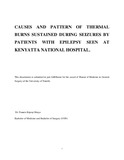| dc.contributor.author | Maiyo, Francis K | |
| dc.date.accessioned | 2013-10-25T09:54:48Z | |
| dc.date.available | 2013-10-25T09:54:48Z | |
| dc.date.issued | 2013 | |
| dc.identifier.citation | Francis Kiprop Maiyo (2013). Causes And Pattern Of Thermal Burns Sustained During Seizures By Patients With Epilepsy Seen AtKenyatta National Hospital. This dissertation is submitted in part fulfillment for the award of Master of Medicine in General Surgery of the University of Nairobi. | en |
| dc.identifier.uri | http://erepository.uonbi.ac.ke:8080/xmlui/handle/11295/57888 | |
| dc.description.abstract | Background: Burns is an important health problem in the developing countries and epilepsy is a
major predisposing factor to severe burns. The severity of burns in these countries is also high.
The total burn surface area and the depth of burns are important prognostic factors. In persons
with epilepsy, the burns may involve a small area but may be deep. Most burns tend to occur in
domestic setting and are more common in females than males. Inadequate seizure control is
noted to increase the risk of burns in persons with epilepsy.
Objective: To describe the causes and pattern of thermal burns sustained during seizures by
persons with epilepsy treated at Kenyatta National Hospital.
Variables that were evaluated are: Causes of burns, depth of burns (superficial, deep or
mixed), distribution of the burns (head and neck, upper limbs or trunk), other injuries sustained
during seizures (cuts, head injuries, fractures, or dislocations) and complications arising from the
burns (contractures, traumatic amputations, wound sepsis, facial disfiguring.)
Study design: Observational descriptive prospective study.
Setting: Kenyatta National Hospital, in Nairobi, Kenya
Study duration: 1st December 2012 to 31st March 2013.
Methods and materials: Purposive sampling method was used to select 30 patients who had
sustained thermal burns during seizures. The causes of burns, their depth, their distribution,
other associated injuries and the complications arising from the burns were documented.
Data collection and statistical analysis: Data was collected from the patients/next of kin and
from their records at Kenyatta National Hospital. Predesigned data collection sheets were used. It
was analyzed using SPSS version 19 and descriptive statistics for sample variables was presented
in form of tables and graphs. Data was considered significant at p≤0.05 and presented with 95%
confidence interval.
Results: These were obtained from 30 PWE who sustained thermal burns during seizures and
treated at KNH. The age ranges was from 10 to 38 years. There were more females than males
who sustained thermal burns during seizures among these patients; ratio 1.3:1. Open flame
caused most thermal burns in this group of patients; (76.7%). Most thermal burns were deep
(53.3%) followed by mixed burns (26.7%). These thermal burns involved areas less than 20%
based on TBSA; this accounting to 83.3%. These burns mainly involved the upper limbs (70%)
and trunk (53.3%). Head injuries and fracture/dislocations were the main injuries associated with
the thermal burns. Sepsis and contractures accounted for the highest percentages of
complications arising from thermal burns while skin grafting and escharectomy were the main
procedures performed in the management of severe burns. Counseling on the risk of burns during
seizures was noted to be statistically significant in reduction of TBSA (P=0.04).
Conclusion: The thermal burns sustained by PWE during seizures occurred in the domestic
setting and affected more females than males. Most thermal burns were deep and required
surgical management. Counseling on the risk of burns during seizures was noted to be associated
with reduction in severity of burns. | en |
| dc.language.iso | en | en |
| dc.publisher | University of Nairobi | en |
| dc.title | Causes and pattern of thermal burns sustained during seizures by patients with epilepsy seen at Kenyatta national hospital. | en |
| dc.type | Thesis | en |
| dc.description.department | a
Department of Psychiatry, University of Nairobi, ; bDepartment of Mental Health, School of Medicine,
Moi University, Eldoret, Kenya | |
| local.publisher | School of Medicine | en |

